European Union vanilla bean sales are projected to grow from USD 2.5 billion in 2025 to approximately USD 4 billion by 2035, recording an absolute increase of USD 1.4 billion over the forecast period. This translates into total growth of 57.6%, with demand forecast to expand at a compound annual growth rate (CAGR) of 4.7% between 2025 and 2035. The overall industry size is expected to grow by nearly 1.6X during the same period, supported by the increasing demand for natural flavoring ingredients, growing clean-label food trends, and developing applications across extract and whole bean formats throughout European food manufacturing and retail channels.
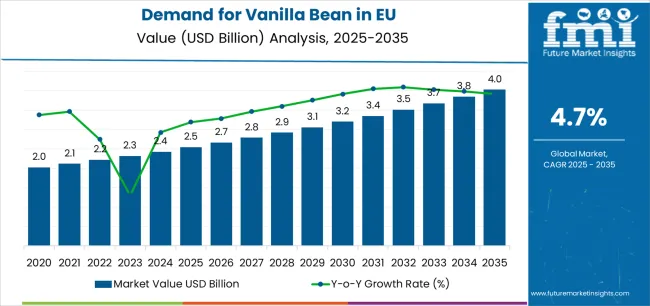
| Metric | Value |
|---|---|
| Estimated Value in (2025E) | USD 2.5 billion |
| Forecast Value in (2035F) | USD 4 billion |
| Forecast CAGR (2025 to 2035) | 4.7% |
Between 2025 and 2030, EU vanilla bean demand is projected to expand from USD 2.5 billion to USD 3.1 billion, resulting in a value increase of USD 655.9 million, which represents 44.8% of the total forecast growth for the decade. This phase of development will be shaped by rising consumer preference for natural flavoring over synthetic alternatives, increasing availability of diverse vanilla products across extract and whole bean formats, and growing mainstream acceptance of premium natural ingredients across food manufacturing and culinary channels. Manufacturers are expanding their product portfolios to address the evolving preferences for authentic vanilla flavor profiles, consistent quality standards, and sustainably sourced formulations comparable to traditional vanilla applications.
From 2030 to 2035, sales are forecast to grow from USD 3.1 billion to USD 4 billion, adding another USD 808.3 million, which constitutes 55.2% of the overall ten-year expansion. This period is expected to be characterized by further expansion of organic and fair-trade varieties, integration of traceability technologies for supply chain transparency, and development of innovative vanilla applications targeting diverse food and beverage segments. The growing emphasis on sustainable sourcing practices and increasing consumer willingness to pay premium prices for ethically sourced vanilla will drive demand for high-quality vanilla bean products that deliver authentic flavor experiences with verified origin credentials.
Between 2020 and 2025, EU vanilla bean sales experienced steady expansion at a CAGR of 4.7%, growing from USD 2 billion to USD 2.5 billion. This period was driven by increasing demand for natural ingredients among European food manufacturers, rising awareness of clean-label product benefits, and growing recognition of vanilla's versatility across multiple food applications. The industry developed as major flavor houses and specialized vanilla processors recognized the commercial potential of premium natural vanilla products. According to peer-referenced data from Future Market Insights (FMI), covering global ingredient sourcing and food innovation, product innovations, improved extraction techniques, and supply chain enhancements began establishing consumer confidence and mainstream acceptance of traceable vanilla bean products.
Industry expansion is being supported by the rapid increase in clean-label food production and the corresponding demand for natural, authentic, and premium flavoring ingredients with proven functionality in bakery, confectionery, and beverage applications. Modern food manufacturers rely on vanilla bean as an essential ingredient for product differentiation, flavor enhancement, and premium positioning, driving demand for products that deliver authentic vanilla flavor, consistent quality, and reliable supply chain transparency. Consumer preference for natural ingredients over artificial flavoring agents has fundamentally transformed vanilla bean from a luxury ingredient to an essential component in premium food formulations.
The growing awareness of sustainable sourcing and increasing recognition of vanilla bean's economic impact on farming communities are driving demand for vanilla bean from certified producers with appropriate quality credentials and traceability systems. Regulatory authorities are increasingly establishing clear guidelines for vanilla labeling, origin declaration standards, and quality requirements to maintain consumer safety and ensure product authenticity. Scientific research and flavor analysis are providing evidence supporting natural vanilla's superior sensory characteristics, requiring specialized cultivation methods and standardized processing protocols for authentic flavor development, optimal vanillin content, and appropriate sensory profiles supporting diverse food manufacturing applications.
Sales are segmented by product type (form), application, distribution channel, nature, and country. By product type, demand is divided into extract and whole bean formats. Based on application, sales are categorized into food, beverage, pharmaceuticals, and other applications. In terms of distribution channel, demand is segmented into supermarket/hypermarket, wholesaler, direct sales, online retailer, and specialty stores. By nature, sales are classified into conventional and organic. Regionally, demand is focused on Germany, France, Italy, Spain, the Netherlands, and the Rest of Europe.
.webp)
The extract segment is projected to account for 65% of EU vanilla bean sales in 2025, expanding to 66.5% by 2035, establishing itself as the dominant format across European food manufacturing and culinary applications. This commanding position is fundamentally supported by vanilla extract's ease of use, consistent flavor delivery, and superior integration capabilities in industrial food production processes. The extract format delivers exceptional manufacturer appeal, providing food processors with a product form that facilitates standardized flavor dosing, simplified inventory management, and quality consistency essential for large-scale production.
This segment benefits from mature processing technologies, well-established distribution networks, and extensive adoption by major food manufacturers who maintain rigorous quality standards and continuous innovation. Vanilla extract offers versatility across various applications, including baking, confectionery production, ice cream manufacturing, and beverage formulation, supported by proven extraction technologies that address traditional challenges in flavor stability and concentration standardization.
The extract segment is expected to increase its share to 66.5% by 2035, demonstrating growing dominance as manufacturers prioritize convenience and consistency in vanilla ingredient selection throughout the forecast period.
Key advantages:
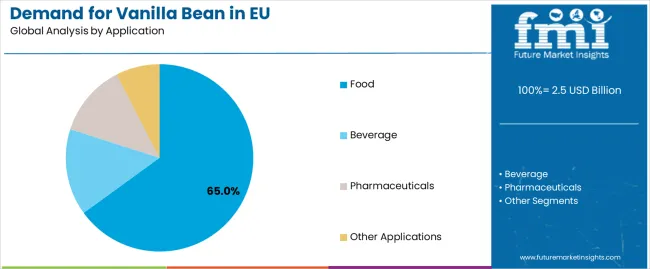
Food applications are positioned to represent 65% of total vanilla bean demand across European operations in 2025, declining slightly to 62% by 2035, reflecting the segment's maturity as the primary consumption category within the overall market. This substantial share directly demonstrates that food manufacturing represents the dominant application, with vanilla bean utilized extensively in bakery products, confectionery items, dairy products, and dessert preparations for flavor enhancement and product differentiation.
Modern food manufacturers increasingly view vanilla bean as an essential premium ingredient, driving demand for products optimized for flavor intensity, authentic taste profiles, and clean-label positioning that resonates with health-conscious consumers. The segment benefits from continuous innovation focused on new product development, premium formulation optimization, and functional ingredient integration enhancing perceived value and taste satisfaction.
The segment's declining share reflects faster expansion in beverage and pharmaceutical applications, which collectively gain market share through innovative product development and expanding use cases throughout the forecast period.
Key drivers:
Supermarket and hypermarket channels are strategically estimated to control 38% of total European vanilla bean sales in 2025, declining to 35% by 2035, reflecting the critical importance of traditional retail availability for driving consumer accessibility and household penetration. European retail operators consistently demonstrate growing shelf space allocation for premium vanilla products that deliver convenient access, quality assurance, and competitive pricing across mainstream grocery channels.
The segment provides essential consumer touchpoints through widespread availability, promotional support driving category awareness, and placement strategies in spice and baking sections where visibility optimizes discovery and purchase decisions. Major European retailers, including Tesco, Carrefour, Rewe, Albert Heijn, and Mercadona, systematically expand vanilla bean selections, often featuring private-label offerings, organic varieties, and fair-trade products that normalize premium vanilla consumption and drive household trial.
The segment's declining share reflects rapid growth in online retail channels, which expand from 15% in 2025 to 22% in 2035, capturing market share through convenience, competitive pricing, and specialized product availability throughout the forecast period.
Success factors:
Conventional vanilla bean products are strategically positioned to contribute 85% of total European sales in 2025, declining to 80% by 2035, representing products produced through standard cultivation and processing without organic certification requirements. These conventional products successfully deliver accessible pricing and consistent quality while ensuring broad commercial availability across all distribution channels that prioritize volume scalability and cost competitiveness over organic certification.
Conventional production serves price-conscious consumers, mainstream food manufacturing applications, and value-oriented buyers that require affordable natural flavoring at competitive price points. The segment derives significant competitive advantages from established supply chains, economies of scale in processing, and the ability to meet substantial volume requirements from major food manufacturers without organic certification constraints limiting raw material sourcing options.
The segment's declining share through 2035 reflects the category's evolution toward premium organic products, which grow from 15% in 2025 to 20% in 2035, as sustainability-conscious consumers and manufacturers increasingly prioritize organic certification and ethical sourcing credentials.
Competitive advantages:
EU vanilla bean sales are advancing steadily due to increasing demand for natural flavoring ingredients, growing clean-label food trends, and rising consumer awareness regarding artificial additive concerns. However, the industry faces challenges, including significant supply volatility driven by weather-dependent cultivation, price fluctuations limiting predictable procurement planning, and synthetic vanillin substitution threats from cost-conscious manufacturers. Continued innovation in sustainable sourcing partnerships and supply chain transparency remains central to industry development.
The rapidly accelerating development of traceability technologies is fundamentally transforming vanilla bean procurement from commodity trading to transparent supply chains, enabling origin verification and ethical sourcing validation previously unattainable through traditional trading systems. Advanced traceability platforms featuring blockchain integration, farmer identification systems, and direct sourcing partnerships allow processors to create verified vanilla products with complete supply chain transparency, ethical labor practices, and genuine sustainability credentials comparable to premium agricultural commodities. These transparency innovations prove particularly transformative for premium food brands and ethical consumers where sourcing integrity proves essential for brand reputation and consumer trust.
Major vanilla processors invest heavily in farmer partnerships, origin verification technologies, and sustainability certification programs, recognizing that traceable products represent breakthrough solutions for supply chain concerns limiting category expansion. Processors collaborate with farming cooperatives, certification bodies, and technology providers to develop scalable systems that verify origin authenticity while maintaining quality standards and fair pricing supporting farmer livelihoods.
Modern vanilla bean suppliers systematically incorporate fair trade certification, organic cultivation standards, and farmer welfare programs that deliver ethical sourcing credentials, social impact validation, and sustainability positioning comparable to premium agricultural commodities. Strategic integration of certification standards optimized for smallholder farming enables suppliers to position vanilla bean as legitimate ethical products where certification directly determines purchasing behavior among sustainability-conscious food manufacturers. These certification improvements prove essential for premium market positioning, as ethical consumers demand transparent sourcing, fair pricing validation, and social impact communication supporting farming communities.
Companies implement extensive certification programs, farmer training initiatives, and premium pricing structures targeting sustainable production, including organic cultivation practices, fair compensation models, and long-term partnership commitments throughout cultivation cycles. Suppliers leverage certification positioning in marketing campaigns, on-pack communication featuring ethical sourcing claims, and sustainability messaging, positioning certified vanilla bean as premium ingredients delivering authentic flavor with social responsibility.
European food manufacturers increasingly prioritize innovative vanilla applications featuring advanced extraction technologies, flavor optimization systems, and specialized processing methods that differentiate premium offerings through superior taste experiences and functional performance. This innovation trend enables manufacturers to drive product differentiation through unique flavor profiles, premium positioning through advanced processing, and competitive advantages resonating with quality-focused food brands seeking natural flavoring without taste compromise. Flavor innovation proves particularly important for confectionery and beverage segments where taste complexity drives category engagement and brand loyalty.
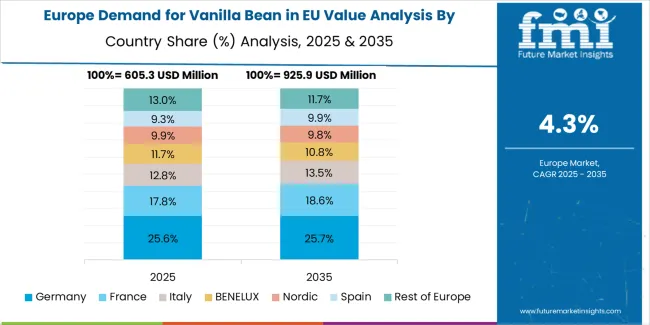
EU vanilla bean sales are projected to grow from USD 2.5 billion in 2025 to USD 4 billion by 2035, registering a CAGR of 4.7% over the forecast period. Spain is expected to demonstrate the strongest growth trajectory with a 5% CAGR, supported by expanding food manufacturing sector, growing confectionery production, and increasing premium food consumption. Italy follows with 4.9% CAGR, attributed to strong culinary traditions and expanding artisanal food production.
Germany maintains the largest share at 28.3% in 2025, driven by established food manufacturing infrastructure and quality-focused consumers, while growing at 4.4% CAGR. France demonstrates 4.8% CAGR, reflecting its strong pastry and confectionery heritage. Netherlands shows a decline at -2% CAGR due to market consolidation, while Rest of Europe records 4.5% CAGR, reflecting diverse regional development stages.
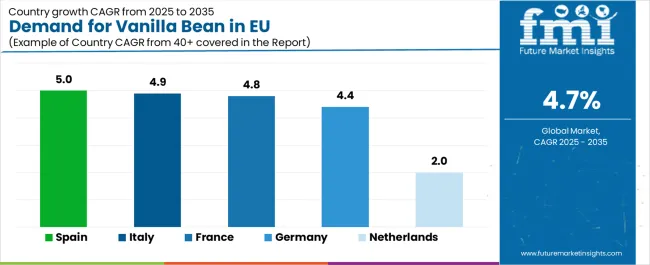
| Country | CAGR % (2025-2035) |
|---|---|
| Spain | 5% |
| Italy | 4.9% |
| France | 4.8% |
| Germany | 4.4% |
| Netherlands | 2% |
EU vanilla bean sales demonstrate solid growth across major European economies, with Spain leading expansion at 5% CAGR through 2035, driven by robust food manufacturing growth and expanding confectionery sector. Italy shows strong growth at 4.9% CAGR through artisanal food production and culinary excellence. France maintains 4.8% CAGR, benefiting from premium bakery traditions. Germany records 4.4% CAGR reflecting established category maturity. Rest of Europe demonstrates 4.5% CAGR with steady mainstream acceptance. Netherlands shows 2% CAGR due to market consolidation. Overall, sales show consistent regional development reflecting EU-wide trends toward natural ingredients and premium food formulations.
Revenue from vanilla bean in Germany is projected to exhibit steady growth with a CAGR of 4.4% through 2035, driven by exceptionally well-developed food manufacturing sector, comprehensive retail infrastructure for premium ingredients, and strong consumer commitment to quality-focused food choices throughout the country. Germany's sophisticated food processing capabilities and internationally recognized leadership in quality standards are creating substantial demand for diverse vanilla bean products across all manufacturing segments.
Major food manufacturers, including confectionery producers, bakery companies, and dairy processors, systematically utilize vanilla bean for premium product formulations, often prioritizing quality ingredients to maintain competitive positioning. German demand benefits from high quality consciousness, substantial food manufacturing capacity supporting industrial volumes, and technical expertise that naturally supports vanilla bean adoption across mainstream food production beyond artisanal applications.
Growth drivers:
Revenue from vanilla bean in France is expanding at a CAGR of 4.8%, supported by France's exceptional culinary traditions, premium bakery sector, and established confectionery industry. France's strong artisanal food culture and sophisticated taste standards are driving demand for quality vanilla bean products across diverse culinary segments.
Major retailers, including Carrefour, Auchan, Leclerc, and specialized gourmet stores including La Grande Épicerie and specialized culinary retailers, maintain comprehensive vanilla bean ranges to serve continuously growing demand. French sales particularly benefit from sophisticated culinary standards demanding superior quality, driving product innovation and premiumization within the vanilla bean category. Artisanal producers and patisserie professionals significantly enhance consumption rates driven by traditional French pastry excellence.
Success factors:
Revenue from vanilla bean in Italy is growing at a robust CAGR of 4.9%, fundamentally driven by strong artisanal food production, progressive gelato manufacturing, and gradual expansion of Italian confectionery sector. Italy's traditionally quality-focused food culture naturally accommodates premium vanilla products as manufacturers recognize flavor benefits and consumer appeal of authentic vanilla ingredients.
Major food producers, including gelato manufacturers, confectionery companies, and artisanal bakeries, strategically invest in vanilla bean utilization for product differentiation and quality enhancement. Italian sales particularly benefit from gelato industry requirements, creating natural adoption among premium ice cream producers, combined with increasing confectionery production in Milan, Turin, and other major cities contributing to expansion through quality-driven purchasing.
Development factors:
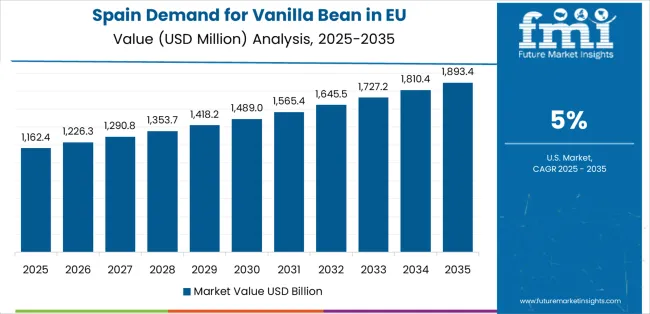
Demand for vanilla bean in Spain is projected to grow at a CAGR of 5%, substantially supported by expanding food manufacturing sector, growing confectionery production through major companies, and increasing tourism-driven hospitality demand. Spanish food industry's modernization and quality improvement positions vanilla bean as aligned with product upgrade strategies.
Major food manufacturers and retailers, including Mercadona's supplier network, confectionery companies, and hospitality ingredient suppliers, systematically expand vanilla bean offerings, with industrial food production proving particularly successful in driving mainstream adoption through volume consumption and quality enhancement. Spain's growing food export sector supports vanilla bean utilization among manufacturers seeking premium positioning.
Growth enablers:
Demand for vanilla bean in the Netherlands is declining at a CAGR of 2%, driven by market consolidation, shifting sourcing patterns, and changing distribution structures within Dutch food manufacturing. While the Netherlands maintains sophisticated food processing capabilities, structural changes in vanilla procurement are temporarily constraining market growth.
The market adjustment reflects optimization of supply chains, consolidation of ingredient sourcing through regional hubs, and strategic repositioning of Dutch operations within broader European manufacturing networks. Despite near-term declines, the Netherlands continues serving as an important distribution center for European vanilla trade.
Market factors:
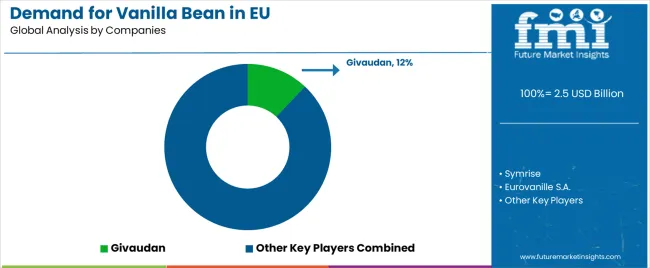
EU vanilla bean sales are defined by competition among multinational flavor companies, specialized vanilla processors, and regional ingredient suppliers. Companies are investing in sustainable sourcing programs, traceability technologies, quality standardization, and farmer partnership initiatives to deliver high-quality, ethically sourced, and transparently traded vanilla bean products. Strategic partnerships with farming cooperatives, distribution expansion initiatives, and marketing campaigns emphasizing origin transparency and sustainability credentials are central to strengthening competitive position.
Major participants include Givaudan with an estimated 12% share, leveraging its global flavor leadership, technical extraction capabilities, and established European presence through comprehensive ingredient solutions. Givaudan benefits from extensive distribution networks, advanced flavor technology expertise, and ability to position vanilla bean alongside synthetic alternatives, supporting diverse customer requirements and application development.
Symrise holds approximately 10% share, emphasizing strong European manufacturing footprint, diverse flavor portfolio, and innovation expertise supporting product development. Symrise's success in developing natural flavor systems with optimized performance creates strong positioning and customer loyalty, supported by technical service capabilities and application expertise.
Eurovanille S.A. accounts for roughly 6% share through its position as specialized European vanilla processor with dedicated sourcing networks, providing premium vanilla products through direct sourcing and specialized processing. The company benefits from origin expertise, established farmer relationships, and specialized vanilla knowledge helping customers understand quality differences, supporting premium positioning and traceability communication.
McCormick & Company represents approximately 4% share, supporting growth through strong retail brand presence, extract product leadership, and consumer-facing vanilla offerings across European markets. McCormick leverages brand recognition, retail distribution strength, and consumer trust, attracting household consumers seeking quality vanilla products with reliable sourcing.
Other companies collectively hold 68% share, reflecting competitive dynamics within European vanilla bean sales, where numerous specialized importers, regional processors, ingredient distributors, and direct sourcing operations serve specific customer requirements, local markets, and niche applications. This competitive environment provides opportunities for differentiation through origin specialization, quality grades, processing methods, and sustainability credentials resonating with food manufacturers seeking authentic vanilla solutions.
| Item | Value |
|---|---|
| Quantitative Units | USD 4,008.2 million |
| Product Type (Form) | Extract, Whole Beans |
| Application | Food, Beverage, Pharmaceuticals, Other Applications |
| Distribution Channel | Supermarket/Hypermarket, Wholesaler, Direct Sales, Online Retailer, Specialty Stores |
| Nature | Conventional, Organic |
| Countries Covered | Germany, France, Italy, Spain, the Netherlands, and the Rest of Europe |
| Key Companies Profiled | Givaudan, Symrise, Eurovanille S.A., McCormick & Company, Specialized processors |
| Additional Attributes | Dollar sales by product type (form), application, distribution channel, and nature; regional demand trends across major European economies; competitive landscape analysis with established flavor companies and specialized vanilla processors; customer preferences for various vanilla formats and quality grades; integration with extraction technologies and sustainable sourcing programs; innovations in traceability systems and farmer partnerships; adoption across food manufacturing and retail channels; regulatory framework analysis for vanilla labeling and natural flavor standards; supply chain strategies; and penetration analysis for premium and mainstream European food manufacturers. |
The global demand for vanilla bean in EU is estimated to be valued at USD 2.5 billion in 2025.
The market size for the demand for vanilla bean in EU is projected to reach USD 4.0 billion by 2035.
The demand for vanilla bean in EU is expected to grow at a 4.7% CAGR between 2025 and 2035.
The key product types in demand for vanilla bean in EU are extract and whole beans.
In terms of application, food segment to command 65.0% share in the demand for vanilla bean in EU in 2025.






Full Research Suite comprises of:
Market outlook & trends analysis
Interviews & case studies
Strategic recommendations
Vendor profiles & capabilities analysis
5-year forecasts
8 regions and 60+ country-level data splits
Market segment data splits
12 months of continuous data updates
DELIVERED AS:
PDF EXCEL ONLINE
Demand Signal Repository Solutions Market Size and Share Forecast Outlook 2025 to 2035
Demand Side Management Market Size and Share Forecast Outlook 2025 to 2035
Demand Response Market Analysis - Size, Share, and Forecast Outlook 2025 to 2035
North America Shipping Supplies Market Trends – Innovations & Growth 2024-2034
Demand of Kozani Saffron in Greece Analysis - Size, Share & Forecast 2025 to 2035
Demand of No-acid Whey Strained Dairy Processing Concepts in European Union Size and Share Forecast Outlook 2025 to 2035
Demand for Bronte Pistachio in Italy Analysis - Size, Share & Forecast 2025 to 2035
Demand and Trend Analysis of Gaming Monitor in Japan Size and Share Forecast Outlook 2025 to 2035
Demand and Trend Analysis of Gaming Monitor in Korea Size and Share Forecast Outlook 2025 to 2035
Demand and Trend Analysis of Gaming Monitor in Western Europe Size and Share Forecast Outlook 2025 to 2035
Demand and Trend Analysis of Yeast in Japan - Size, Share, and Forecast Outlook 2025 to 2035
Demand and Trends Analysis of Stevia in Japan Size and Share Forecast Outlook 2025 to 2035
Demand of Pistachio-based desserts & ingredients in France Analysis - Size, Share & Forecast 2025 to 2035
Japan Women’s Intimate Care Market Trends – Growth & Forecast 2024-2034
Western Europe Men’s Skincare Market Analysis – Forecast 2023-2033
Demand and Trend Analysis of Fabric Stain Remover in Korea Size and Share Forecast Outlook 2025 to 2035
Demand and Sales Analysis of Paper Cup in Japan Size and Share Forecast Outlook 2025 to 2035
Demand and Sales Analysis of Paper Cup in Korea Size and Share Forecast Outlook 2025 to 2035
Demand of MFGM-enriched Powders & RTDs in European Union Size and Share Forecast Outlook 2025 to 2035
Demand and Sales Analysis of Paper Cup in Western Europe Size and Share Forecast Outlook 2025 to 2035

Thank you!
You will receive an email from our Business Development Manager. Please be sure to check your SPAM/JUNK folder too.
Chat With
MaRIA